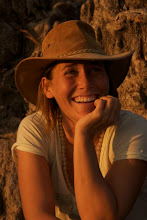They are everywhere. They come in all shapes and sizes. These grey sculpted sand mounds seem to extend out of the ground providing the only rise in an otherwise extremely flat Okavango landscape. When I scope the horizon for game, they stand out and are often the first thing I see. I have at times mistaken them for a far off Elephant or other animal. I now have a better-trained eye and can tell the difference. I believe Graham is thankful for this quick learning curve.
When I first arrived, I was fascinated by these mounds. Some are huge amazing structures of architecture, others resemble abstract forms of people with branches as arms.
Somewhat fancifully I will admit, they appeared to me to exist in villages of sorts, and as in all urban planning of societal class: upper class, middle class and the slums. Some exist in neighborhoods, or the suburbs, some in a lovely country setting with beautiful landscaping of cornflower vernonia and a well maintained lawn around it. As it turns out, when I mentioned this observation I did learn that the termites actually do excavate around the mounds to feed so it appears as though someone has actually mowed it. Some seem to have flat tops that resemble a roof top patio, and others mutli-level dwellings. The way they appear at times one would wonder if they ever get together for dinner parties. Well that was my take. Graham seemed to think this theory was a little off kilter, and by the look on his face questioned my sanity a little.
As it turns out, these mounds are extremely useful. I have witnessed many animals using the mounds as a perch to see what potential prey (or predator for that matter) may lie in the horizon. Lions, leopards and cheetah, monkeys, baboons and antelope all use them as vantage points. Aside from being very useful for the local wildlife, once disused they prove very useful for us humans. They make excellent base structure for long drops, as mentioned in my camp life post, and sand boxes for the kids. They can even be used as wood-fire ovens.
I was not far off on my observation that these look like tiny cities or replicate homes. There are literally millions of termites living in one mound so they must manage their habitat to maintain temperature and moisture while protecting their huge communities from the harsh environment. Termite mounds have flues (if I may call them that), which vent through the top and sides with the mound designed to catch a breeze. As the wind blows, hot air from the below ground is drawn out of the chamber helped by the worker termites by opening or blocking tunnels to control air flow. Termites are architectural geniuses and would that humankind could learn from their ability to survive and build their homes using only renewable energy sources.
If lion is the king of the bush, termite is architect of the Okavango. These seemingly random mounds and tiny insects form many of the islands that make up the Delta and play a vital role in the functioning of this ecosystem. If a new fledgling mound establishes in a floodplain and survives the first annual flood, it will eventually become an island.
Silt is deposited on their margins and they grow slowly outward. Seeds germinate easily in the moist soil and once the plants start growing they are protected from grass fires due to the elevation of the mound. These plants take root and gather more silt, a process that continues indeterminably, growing the island gradually outwards.
Termites are efficient decomposers. They feed on dead plant material and return the plant nutrients to the soil through their faeces and saliva. There may be as many as 10 000 termites to a square meter of soil hence also playing a part in the diet and nutrients of other species.
And so once again I have been taught a lesson here in the Delta. Once thought of as pests, or some silly fictitious village to entertain my imagination while looking for the lions, I now have a new appreciation of these brilliant critters and will admire them and respect them for the vital role they play in the intricate web of life here.


No comments:
Post a Comment